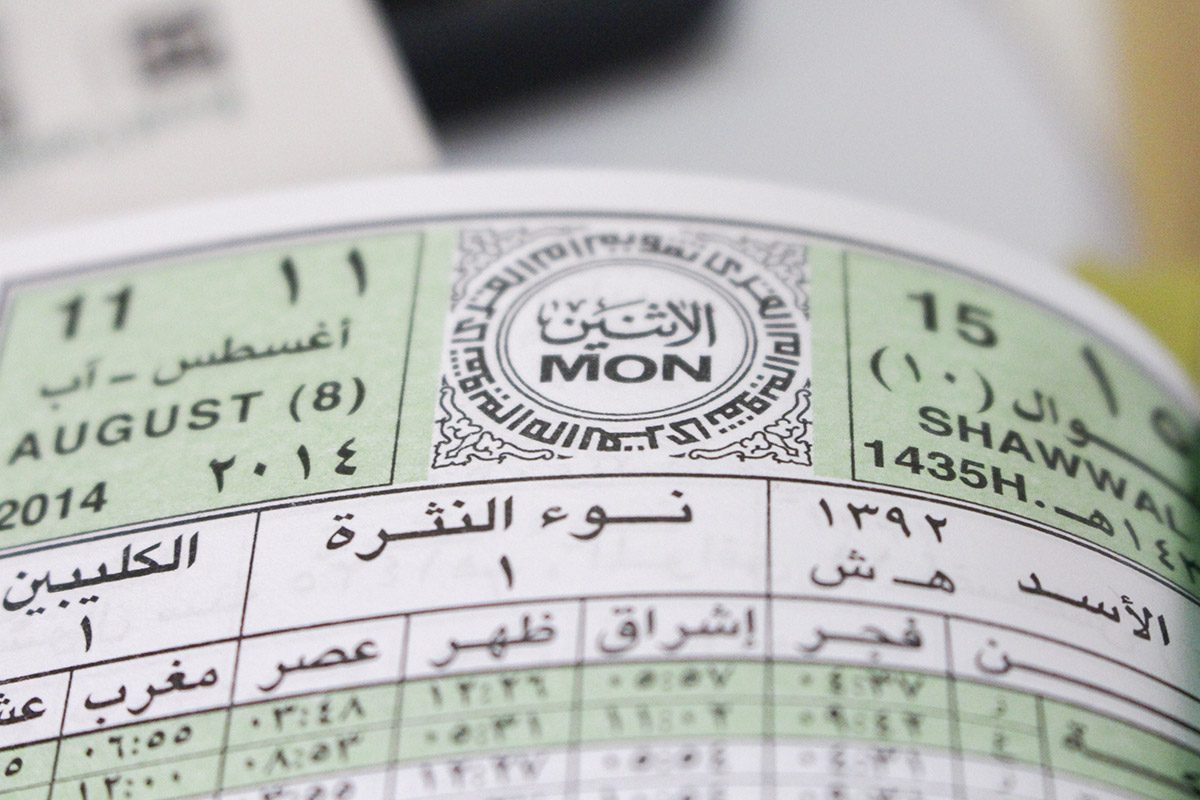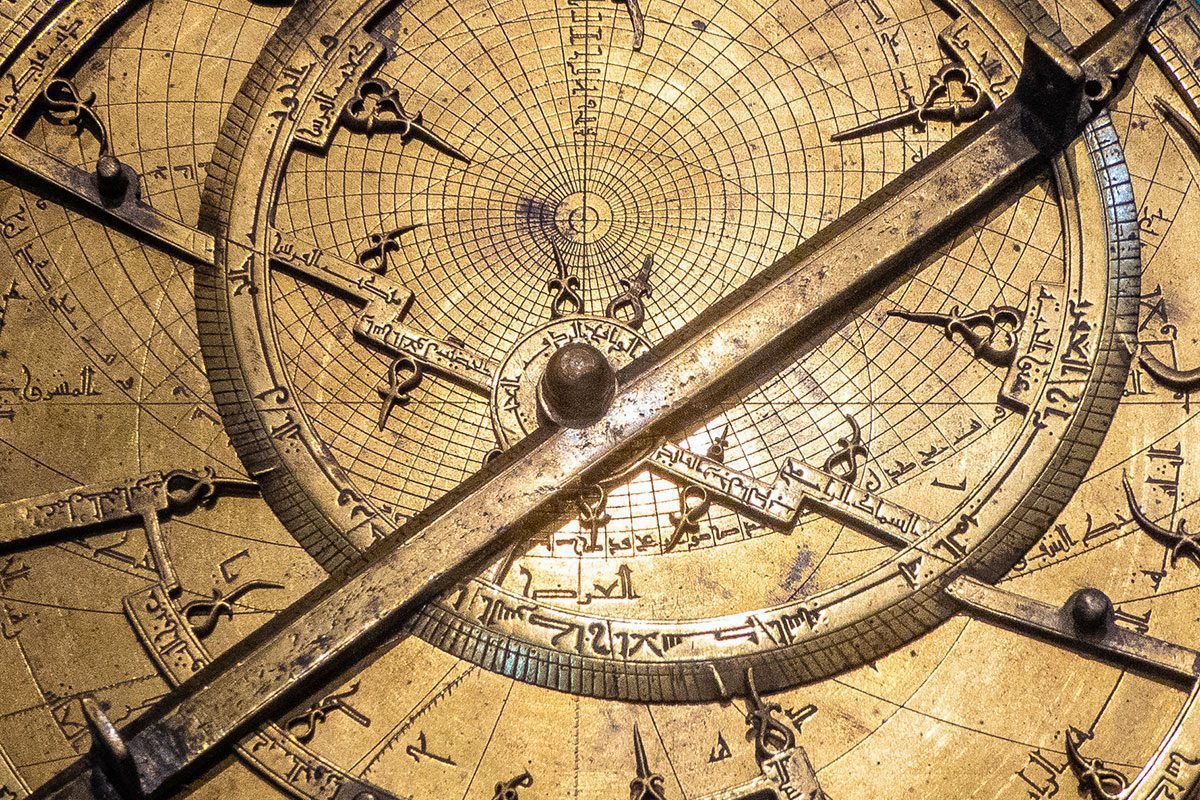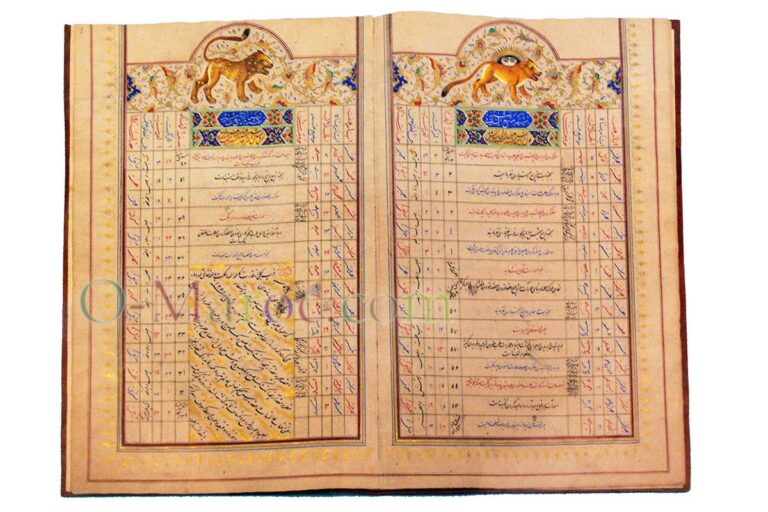A lunar calendar
The Muslim calendar, or Hijri, is a lunar calendar, unlike the pre-Muslim Arab calendar, of Aramaic origin, which regularly included an extra month to keep in step with the solar year.
It was with the Quran that the calendar became exclusively lunar.
[New moons] “They are measurements of time for the people and for Hajj” (2- 189)
and the months begin with the sighting of the new moon. Made up of 12 months of 29 or 30 days, it shifts every year by 10 or 11 days in relation to the Western calendar (Gregorian) and completes one full revolution in 36 years.
F
| N° |
Name
|
Meaning | |
| 1 |
محرّم
|
Muharram | Forbidden |
|---|---|---|---|
| 2 |
صفر
|
Safar | Void |
| 3 |
ربيع الأول
|
Rabi’ al awwal (Rabi I) | First spring |
| 4 |
ربيع الآخر
|
Rabi’ al thani (Rabi II) | Second/Last spring |
| 5 |
جمادى الأول
|
Jumada al awwal (Jumada I) | First of parched land |
| 6 |
جمادى الآخر
|
Jumada al thani (Jumada II) | Second/Last of parched land |
| 7 |
رجب
|
Rajab | Respect, honour |
| 8 |
شعبان
|
Sha’ban | Scattered |
| 9 |
رمضان
|
Ramadan | Burning heat |
| 10 |
شوّال
|
Shawwal | Raised or Hunting |
| 11 |
ذو القعدة
|
Dhu al-Qi’dah | Truce/sitting |
| 12 |
ذو الحجة
|
Dhu al-Hijjah | Pilgrimage |
Four of these months are sacred: Muharram, Rajab, Dhu al-Qi’dah and Dhu al-Hijjah. But not the month of Ramadan.
It is thought that the “sacred” nature of these months is pre-Islamic and has been taken over. Muharram is the month in which fighting was forbidden, as were Rajab, Dhu al-Qi’dah and Dhu al-Hijjah. If we add the “empty” month, when the tribes left on caravans, and Ramadan, we can see that the time when war was possible represented only half the year.
A calendar that begins with the Hegira
It was Caliph Omar (634-644) who established the Muslim calendar, taking as his starting point Muhammad’s exile from Mecca to Medina on 16 July 622.
This is year 1 of the Hegira, and the 1st Muharram of year I.
Why choose this date?
The flight to Medina is one of the turning points in the history of Islam, one of its founding acts.
It was not advisable to choose the date of Mohammed’s death, a sad day that cannot begin a new era, and the date of his birth was not known with certainty.
Switching from the Gregorian to the Hijri calendar
Here is the rule for changing from a Gregorian year (G) to a Muslim year (H):
G=H+622-(H/33)
H=G-622+[(G-622)/32]
So, to convert the year 2005 to the solar calendar: H=2005-622+[(2005-622)/32]=1426th year since the Hegira.
In practice, today in Morocco (and everywhere in the Arab world, I think) “Muslim” calendars are published using both systems:

Structuring time in the Muslim calendar
Muslims have adopted the 7-day week, starting on Sunday. Only Friday has a special name.
The day (and therefore the month, and the year…) begins in the evening, and is divided into five unequal parts that vary throughout the year, since they depend on sunset (the moment when you can no longer tell a white thread from a black one).
Al maghrib, sunset
Al isha, the second hour of the night
Al sobh, dawn
Ad dhuhr, midday
Al asr, mid-afternoon.
These five parts correspond to the five Muslim prayers. For those who live in Morocco, the voice of the muezzin quickly becomes as familiar as the sound of bells.
Friday was chosen as the day of prayer by the Prophet. Perhaps to set himself apart from the Jews and Christians, but also because the Hegira took place on a Friday, and finally Friday was traditionally the day of assembly.
In fact, the name of the mosque in Arabic, jûmi, has the same root as assembly, jûmu’a .
The beginning of the day and the month are determined by visual observation, “unless it is proved by astronomical calculation that such observation is impossible“.
Muslim astronomers and the astrolabe
Muslims were great astronomers, perfecting the ancient Greek astrolabe. This representation of the celestial vault was as useful for measuring time as it was for navigation.
It was used to determine the start and end dates of the lunar months, when astronomical calculations had to be used.
The astrolabe was also used to determine prayer times during the day. Many astrolabes bear symbols to identify the prayers during the day (al dhuhr and al asr) as well as markers to identify the qibla, the direction of Mecca.

This post first appeared in March 2012, on the website of the now-closed Mezgarne agency.
 A typo or syntax error? You can select the text and hit Ctrl+Enter to send us a message. Thank you! If this post interested you, maybe you can also leave a comment. We'd love to exchange with you !
A typo or syntax error? You can select the text and hit Ctrl+Enter to send us a message. Thank you! If this post interested you, maybe you can also leave a comment. We'd love to exchange with you !




